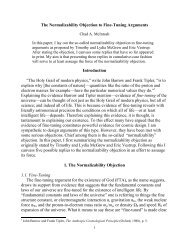Theism and Explanation - Appeared-to-Blogly
Theism and Explanation - Appeared-to-Blogly
Theism and Explanation - Appeared-to-Blogly
You also want an ePaper? Increase the reach of your titles
YUMPU automatically turns print PDFs into web optimized ePapers that Google loves.
28 <strong>Theism</strong> <strong>and</strong> <strong>Explanation</strong><br />
clarifi ed what I mean by a potential explanation. Let me begin by returning<br />
for a moment <strong>to</strong> Peirce’s schema.<br />
(1) The surprising fact, E, is observed.<br />
(2) But if H were true, E would be a matter of course,<br />
(3) Hence, there is reason <strong>to</strong> suspect that H is true.<br />
I have argued that a potential explanation is an account that satisfi es the<br />
second premise (line 2) of Peirce’s schema. Now Peirce’s schema as a whole<br />
tells us what might warrant our acceptance of a proposed explanation. But<br />
it tells us nothing about the shape of the explanation itself. It does not tell<br />
us just what it means <strong>to</strong> say that “if H were true, E would be a matter of<br />
course” (line 2).<br />
There are two ways in which this question has commonly been answered.<br />
The fi rst is <strong>to</strong> argue that H entails E, the explanation in question taking<br />
the form of a deductive argument. I shall refer <strong>to</strong> this as a “deductivist”<br />
approach <strong>to</strong> explanation. The second is <strong>to</strong> argue that H renders E more<br />
likely than it would be otherwise. More precisely, this approach argues that<br />
truth of H makes E more likely than it would be if H were not true:<br />
Pr(E|H) > Pr(E|H).<br />
I shall refer <strong>to</strong> this as a “probabilistic” approach <strong>to</strong> explanation. Among<br />
proponents of theistic explanations, Richard Swinburne adopts the probabilistic<br />
approach. While recognising that theistic explanations are intentional<br />
explanations, 46 his arguments assume that the existence of a divine<br />
agent would render the explan<strong>and</strong>um more likely that it would be otherwise.<br />
I shall examine Swinburne’s arguments in more detail later (6.1.2).<br />
All I want <strong>to</strong> note here is that I shall be adopting the fi rst, deductivist view.<br />
This is not because I believe that all explanations can be reduced <strong>to</strong> deductive<br />
arguments. (Perhaps they can; perhaps they can’t. I’m not sure.) It is because<br />
proposed theistic explanations are a species of intentional explanation <strong>and</strong><br />
intentional explanations, I shall argue (Appendix 2.1), are best reconstructed<br />
as deductive arguments. From a deductivist point of view, if one can deduce<br />
a description of the explan<strong>and</strong>um from the hypothesis, then one’s hypothesis<br />
corresponds <strong>to</strong> the second premise (line 2) of Peirce’s schema. It will show<br />
why, given the truth of H, we would expect <strong>to</strong> observe E.<br />
Note that, assuming that one can make sense of the relevant notion of<br />
probability (2.1.3.1), a deductivist approach <strong>to</strong> explanation does not necessarily<br />
exclude probability calculations. It is true that, on this view, the<br />
explanation itself would not be probabilistic, in the sense of assigning a<br />
certain probability <strong>to</strong> the explan<strong>and</strong>um (perhaps in the light of a statistical<br />
law). If the deductive argument it embodies is sound, then the likelihood<br />
of the explan<strong>and</strong>um, given the hypothesis, is 1.0. If one wanted <strong>to</strong> speak<br />
of “confi rmation” in this context (perhaps adopting Hempel’s entailment



